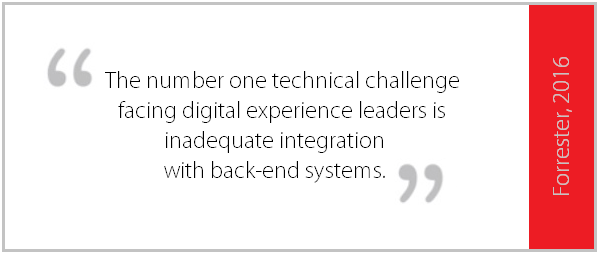Recently, Gartner reported that more than half of all organizations they surveyed owned two or more web content management (WCM) solutions. This is indicative of a major problem in digital business today: many enterprises are wasting time trying to piece together solutions that weren't designed to work together. What's worse, they're managing them with separate processes.
It's hard to take steps forward when time is spent down in the weeds of software integration and syncing up data across systems.
In order to grow a business, companies need to have a better understanding of their customers (and their entire ecosystem, for that matter). Having the right platform can provide a single, unified view of the customer by drawing information from various touchpoints. In this way, businesses can use the data to improve customer experience across all channels.
Identifying the Key Needs for Digital Business

Digital experiences present great opportunities for digital business, but with these opportunities come challenges in creating and managing touchpoints. Companies are now asking: How do I solve the real problem of delivering our services across channels in a practical, valuable way to our customers? These are some of the common needs companies are encountering in digital transformation:
- Integrating disjointed technologies
- Creating a complete view of the customer experience
- Unifying the organizational approach to digital strategy
- Addressing the entire customer lifecycle
- Transitioning from legacy systems
According to the Harvard Business Review, customers think of digital experience like viewing a mosaic—all touchpoints should add up to one brand image. Customers should come away with a cohesive and positive image of your product or service, even if that interaction is limited to one or two touchpoints.
The problem is that channels are multiplying and overlapping in a way that yesterday’s software solutions aren’t equipped to keep up with, and the amount of data being captured is overwhelming. With fragmented systems and issues of data management, companies are running the risk of losing that singular brand image.
What's the Solution?
Digital experience platforms are a response to these key needs. With the right platform, companies can give customers access to what they want on whatever channel they want, which provides a better experience.
Additionally, they can draw in data from new channels or previously unmanaged channels and use those insights to make decisions on new products, services or business processes that will continue to refine the customer experience. They can manage and unify disparate systems and channels, while providing an architecture that allows for integration. Together, this means that digital transformation technologies are opening new doors in company-customer relationships that can drive future innovation and growth.
Digital experience platforms enable companies to conquer the challenge of managing touchpoints and the data they bring in, resulting in more agile and streamlined business processes. They will empower companies to deliver exceptional experiences to their increasingly connected customers.
Moving Forward
As the demand for personalized, connected experiences rises, so too does the need for digital experience platforms. Companies are looking for technology that can unite customers’ experiences across digital devices and manage the many channels of interaction. Having the right digital experience platform is what businesses should aspire to include in their current strategy.